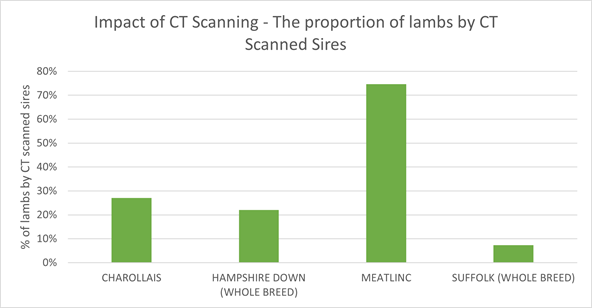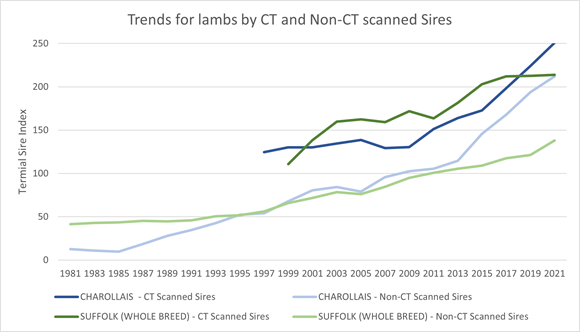Utilising technology to make informed breeding decisions and identify animals with superior muscle across the carcase can increase carcase yield and the profitability of sheep enterprises. Laura Eyles, Senior Signet Breeding Specialist, explains how levy funded research and investment in the late 1990’s has allowed this world leading technology to be used within our sheep industry.
Computed Tomography (CT) scanning is a great tool for identifying superior genetics within terminal sire flocks and can assist the marketing of recorded rams. CT is a welfare friendly way of assessing the total muscle, fat, and bone yield in a live sheep, where medical imaging technology produces pictures of the body using low dose X-rays. CT allows a near perfect prediction of carcase composition and muscle yield, it can also be used to measure muscling in different parts of the carcase, such as the rib, loin, and gigot.
Since CT scanning services were launched in the late 1990s through levy funded research this world leading technology has allowed more than 13,500 lambs from 21 different breeds to be scanned, with their data analysed within Signet’s monthly evaluations. This service enables ram breeders to select breeding lines with superior yields of meat at a given liveweight, whilst providing additional measurements from the loin and gigot.
Furthermore, the use of CT has enhanced our understanding of the relationship between on-farm ultrasonic measurements of muscle and fat depth and the amount of lean and fat in the carcase. This has enhanced the value of on-farm ultrasound and strengthened Signet’s breeding evaluations. Incorporating CT data into the evaluation of a flock greatly enhances the accuracy of Estimated Breeding Values (EBVs) for growth and carcass traits, with EBVs and Indexes increasing if the data demonstrates that an individual animal or family are genetically superior. This allows breeders and buyers alike to have greater confidence in an animal’s breeding values.
Changes to the way we use CT data
Historically carcase traits have been adjusted in Signet’s analysis for age, however this means that observed increases in muscling are confounded with increases in growth rate. The bigger sheep, unsurprisingly, tend to have more muscle in their carcases at a fixed age. In the UK, whilst lamb growth rate is important (and EBVs for this trait are readily available), lambs tend to be slaughtered at a fixed weight and ideally a similar level of finish. For this reason, Signet changed the terminal sire evaluation to develop weight adjusted carcase traits that would highlight differences in lambs killed at a similar slaughter weight.
Breeding for gigot shape and conformation
Breeders that are using CT technology also have EBVs that help them identify sheep that have better muscularity of the hind leg, or gigot.
The production of a Gigot Muscularity EBV was made possible following levy funded research at SRUC to develop a muscularity measure that identifies sheep with wide gigots. Work within the RamCompare project has shown that rams with high EBVs for this trait are leaving lambs with superior carcase conformation.
Using CT to enhance ease of lambing
Recent research suggests that CT measurements of the hip, shoulder and pelvis can be used as a
proxy for assessing ease of birth. This work highlighting future opportunities for the CT unit in producing EBVs that can also improve animal welfare.
Who benefits from this work
CT scanning is a world leading technology that’s available to all UK sheep breeders and it is having an impact with around a quarter of Charollais and Hampshire Down lambs sired by a CT scanned ram in recent years – and the vast majority of Meatlinc rams, with Meatlinc breeders quick to integrate CT data into their breeding programme.
Utilisation of these CT scanned sires for breeding purposes has increased in recent years with more breeders selecting CT scanned stock. As a result, rates of genetic gain for growth and carcase traits are significantly higher in flocks using CT scanned rams and at a flock level, the use of CT is therefore helping to maximise returns within both pedigree and commercial flocks.

This work provides wider benefits throughout the supply chain. Processors and retailers can secure lambs that more closely meet their specifications and provide greater consistency consumers benefit from lamb with better eating quality, with less plate waste and that is capable of being produced at lower cost.
CT scanning is a great example of a technology from which everyone can benefit, having a high industry impact and overall cost benefit; CT scanning is a great use of levy funds.
Where can I access this service and how much does it cost:
SRUC run a mobile CT unit; this provides breeders with easy access to this service right around the country. Dates and locations are published yearly so keep your eyes peeled or contact the team at [email protected] directly.
The cost varies depending on whether breeders used the static CT scanner at Edinburgh or the mobile service, but CT typically costs between £70 and £100/animal. However, levy support is often available from AHDB, HCC and QMS.
It will never be economically or logistically possible to scan all potential rams in a breeding scheme so in the UK a two-tier approach has been developed, using ultrasound to identify the best candidates for CT scanning.
While the service is expensive for individual breeders, the benefits to the wider industry are massive and that is why AHDB has been so keen to support its use over the last two decades.
Subsidy is subject the following conditions:
- Lambs are male and scanned using ultrasound at an acceptable age.
- At least five ram lambs must be sent per participating farm.
- Lambs must have been reared under similar conditions.
- Lambs must have an individual identification that can be readily linked to information on the Signet database.





